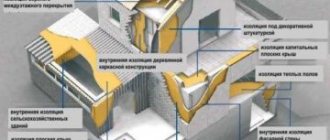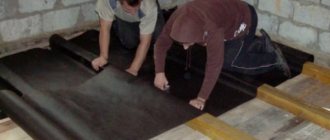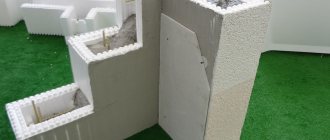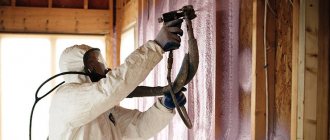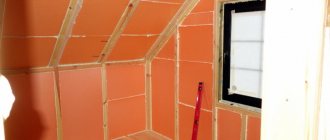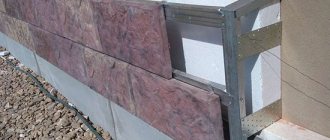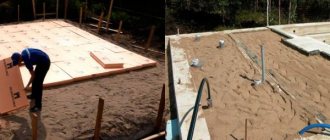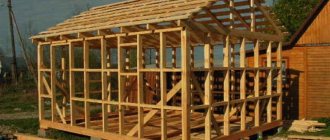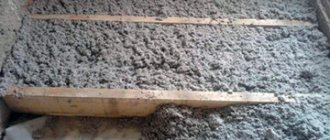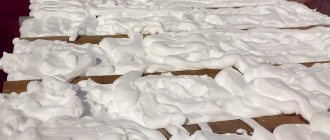The unique thermal insulation properties of polyurethane foams (PPU) have been known and in demand in construction, mechanical engineering and many other areas of human activity for more than 70 years. However, foundation insulation with polyurethane foam has become widespread only in recent years due to the development of jet application (spraying) technology. It is necessary to immediately make a reservation that we are talking about hard types of frozen foam. Depending on the rate of polymerization and the ratio of the base components (polyols and isocyanurates), the result of the reaction is an elastic (foam rubber) or rigid structural material. The application of the latter will be discussed in this article.
Comparison of polyurethane foam with other heat insulators
In terms of thermal conductivity (0.021 - 0.029 W/(m K)), polyurethane foam is second only to aerogels. But the scope of aerogels is still limited primarily to exotic, highly scientific high-tech. The performance of the closest real competitor - extruded polystyrene foam (EPS) - is on average 20% worse (Kt = 0.029 - 0.032 W/(m K)).
As for other physical properties of polyurethane foam that are important in construction practice:
- Compressive strength is up to 120 - 150 kPa. Corresponds to brands of medium-density foam, inferior to EPS.
- Moisture permeability - no more than 1%. Polyurethane foam accumulates more moisture than EPS, but significantly less than other building thermal insulators.
- Chemical inertness. Resistant to all types of organic solvents, as well as acids and alkalis of low and medium concentrations.
- Degree of adhesion with the insulated base. Exceptionally high adhesion to the surface due to the spraying features. What is especially important is that it does not depend on the shape, degree of roughness and type of surface material.
- Fire danger level. From G1 to G4 depending on the addition of fire retardants. However, fire-fighting additives reduce the energy efficiency and service life of polyurethane foam insulation.
- Price. The price of spraying a 50 mm thick polyurethane foam coating in regional centers of the Russian Federation is $10.5 - $13.5 per 1 sq. m. m. depending on the density of polyurethane foam (we are talking about a closed-cell material). This is significantly more expensive than the cost of EPS boards (about 3 times) and polystyrene foam. However, it is necessary to compare the economic efficiency of work taking into account the cost of all related operations.
- Requires protection from UV radiation. It is not recommended to stand in the sun without shelter for more than 3 - 4 days.
Features of polyurethane foam insulation
Polyurethane foam is a synthetic material with a porous structure, widely used in the construction industry as insulation. Working with this material differs in the specifics of its preparation and application.
To obtain the material, two components (polyol and isocyanate) are combined. As a result of mixing substances, foaming occurs. The foam increases in volume within a few minutes and begins to harden, forming a cellular composition. Upon reaching strength, the PU foam structure has the following parameters:
- Weight – 1.8 kg/m2 (with a thickness of 3 cm).
- Density – 60 kg/m3.
- Thermal conductivity – from 0.029 to 0.041 W/(m•K).
- Operating temperature range – -100°C/+100°C.
Polyurethane foam is applied to the internal or external surface of the base. Insulation from the inside is carried out if it is not possible to carry out work from the outside. No special preparation is required; the material is evenly distributed over the surface of the structure. The standard layer thickness is 6 cm. Hardening occurs in a few minutes, and the color of the foam changes.
PPU is not dangerous, but in order to avoid unpleasant health consequences, precautions must be taken. It is recommended to carry out work wearing eye and skin protection. In case of contact with the skin, wash off the substance as quickly as possible and treat the area with a moisturizer.
Insulation using this method will not be difficult; the procedure is similar to applying polyurethane foam.
Insulating the PPU foundation has both advantages and disadvantages.
At the moment, polyurethane foam is the most effective insulation for foundations
In what cases is it preferable to insulate the foundation with polyurethane foam?
From the point of view of energy efficiency, polyurethane foams are superior to polystyrenes, however, the lower price of the latter makes it possible to compensate for the properties of the layer by increasing its thickness. On the other hand, there are certain technological factors that make it advisable to use polyurethane foam.
Foundation insulated with polyurethane foam
Difficult foundation terrain
One of the disadvantages of thermal insulation of the foundation using slab materials is the formation of voids between the insulation and the mounting surface. There is a high probability of moisture getting into these cavities and the formation of unaccounted for cold bridges. In addition, significant differences in flatness make it impossible to cladding some surfaces without attaching complex sheathing. Such objects include the stone foundations of old buildings. Issues of insulation acquire particular importance if, according to their status, the buildings are classified as architectural monuments. Internal and external insulation of such objects is carried out using foam spraying technologies.
Significant insulation areas
The more difficult it is to control the integrity of the insulating layer, the more relevant it becomes to use materials with high adhesion that fill all joints and voids. Imagine a strip foundation with a surface area of several hundred square meters. m. It is almost impossible to guarantee 100% sealing of all joints when covering such a surface with EPS or foam boards. In addition, large volumes of work make it possible to reduce prices for polyurethane foam insulation by 10% - 15%.
Limited time for work
A team of two people can apply polyurethane foam to an area of 400 - 500 square meters during one work shift. m. If we take into account the high speed of final polymerization of the material and ventilation of the premises (maximum - several hours), then the method is ideal for emergency work. For many commercial facilities, the time of interruption of operation or partial deterioration in customer service conditions is a critical parameter.
The importance of soundproofing
In cases where noise control is no less important than energy saving, the use of polyurethane foams becomes a priority. The suppression of sound waves in the PU foam environment occurs not only due to porosity, but also due to the fact that the coating acts as a massive solid damping shell.
Arguments in favor of foundation insulation
- Preventing heat loss. As already mentioned, without insulation, the heating of the house will increase by at least 10%; they will simply go outside.
- Saving on utility bills. Yes, you will spend money on materials for insulation and labor on work, but in the future you will more than recoup all these expenses, noticing how your heating bills have decreased.
- No temperature changes. Due to the absence of hot spots for heat loss, the basement will always be constantly warm.
- Waterproofing the house. Covering the base of the house from the outside with insulating materials will prevent moisture from getting inside, and there will be no dampness or unpleasant odor in the room.
- Preventing foundation freezing. If its horizontal part has not been insulated, then when the soil underneath it deforms, it may freeze and become not as durable as it could be.
- Extending the service life of the foundation as a whole. The less destructive forces affect it, the more it “lives.”
It is necessary to insulate the foundation from the outside, because by insulating it from the inside, you will protect the room from heat loss, but will not protect the foundation itself from destructive moisture and cold.
Polyurethane foam application technology
The sprayed composition is two-component. Polyols and isocyanurates are supplied in separate containers. Most installations for applying polyurethane foam have the following operating configuration:
- Blower compressor. Creates excess pressure in working tanks.
- Working containers. Depending on the component supplier. Usually these are standard steel barrels of 150 - 200 liters.
- Mixture preparation apparatus. It consists of two pumps and a central control panel, where the components are mixed and (if necessary) heated to the required temperature.
- Application gun and flexible hose kit.
Equipment for applying polyurethane foam
In addition, plant operators must wear protective suits, goggles and respirators. During the polymerization process, gaseous substances hazardous to health are released.
The physical properties of the insulating layer depend on many factors: the proportions of mixing the components, the temperature of the mixture, the pressure of the mixture at the outlet, the temperature and humidity of the environment, the thermal conductivity of the insulated surface. Thus, obtaining insulation with comparable characteristics requires prompt adjustment of parameters when applying the mixture from concrete to metal or when the weather changes.
The surface of the foundation is cleaned of dirt and paint. Loose fragments are removed. Depending on the qualifications of the craftsmen and the technology used, drying may be required.
A number of experts consider it necessary to apply waterproofing bitumen mastic before work. However, this is not urgently necessary: the foam itself has waterproofing properties. In some cases, with significant porosity of the base, it makes sense to pre-prime in order to reduce the consumption of polymers.
The mixture is applied in liquid form to the surface in a continuous layer, or the cells of the existing sheathing are filled. The composition expands approximately 100 times upon polymerization. Therefore, to obtain a layer close in thickness to the required one, some experience is required.
A polyurethane foam thickness of 3 - 5 cm is considered the minimum basic thickness. If more significant insulation is required, a second layer is applied.
When working with polyurethane foam, you must wear a protective suit
If you called a team to thermally insulate the foundation with sprayed polyurethane foam, you should prepare the working conditions:
- The trench exposing the surface must be at least 70 cm wide.
- The surface must be cleaned and dried.
- The electricity supply must provide at least 5 kW of power.
- Have material to cover the resulting surface from exposure to uv radiation.
Independent use of the described technology does not make much sense for many reasons. Firstly, you need to have a set of expensive equipment. Rent, accordingly, will also not be cheap. Secondly, it requires professional skills that are not acquired through a few square meters of trial application. Thirdly, the basic amount of polymer contained in two barrels is about 300 kg, and for insulating a shallow strip foundation of a house with an area of about 100 square meters. m. takes, on average, no more than 40 - 50 kg. There are compact kits for repair insulation, but the cost of the material in them is much higher, and the quality of the resulting insulation leaves much to be desired.
Step-by-step instructions for insulating a polyurethane foam foundation using the example of using POLYNOR® sprayed polyurethane insulation
Still, it is possible to apply polyurethane foam yourself. One option is the Polynor composition. Here are photo instructions for insulating a foundation wall with NPU POLYNOR
. The work is not difficult and is suitable for do-it-yourself insulation. Only one person is involved in the insulation process. In this example, the insulation area is 34 m2, the thickness of the two-layer thermal insulation is 120 mm, the process took 2 hours.
The foundation surface is prepared for applying thermal insulation
Apply Polynor composition to the surface of the foundation
Cans with sprayed insulation
You need to work using protective equipment
Polynor application is nearing completion
Close-up of polyurethane foam insulation
Polyurethane foam insulation boards
RIP board - ready-made polyurethane foam
Information about insulating foundations using polyurethane foam would be incomplete if we did not mention PIR insulating boards. They are similar to EPS: the same thickness, the same “quarter” mounting pattern. A characteristic feature of PIR is its cladding with layers of aluminum foil. Due to this, the fire resistance of the material increases to the “non-flammable” category. PIR slabs are ideal for internal thermal insulation of foundations, providing the highest possible heat savings with minimal coating thicknesses. The fire safety of the material is relevant for finishing used basements. In addition, aluminum foil for a number of rooms can be considered sufficient in terms of aesthetics and does not require additional finishing coatings.
